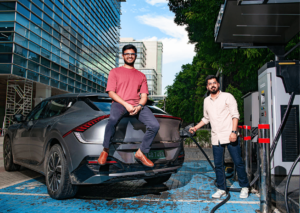Recognizing the rising demand for electric vehicles (EVs) in India, two entrepreneurs launched a scalable hardware and software solution to bridge the gap in charging infrastructure. Established in 2019, Statiq has grown into the country’s second-largest EV charging network, holding a 22% market share with over 8,000 chargers integrated into its app.
India’s EV adoption is surging, with over four million electric vehicles on the roads. In FY24 alone, EV sales surpassed 1.7 million units, marking a 40.31% year-on-year increase. Projections indicate annual sales could hit 10 million by 2030. Statiq is positioning itself as a key player in this evolving market.
From Startup Lessons to EV Charging Innovation
Gurugram-based Statiq was founded by Akshit Bansal (CEO) and Raghav Arora (CTO), who previously launched Sharify, a vehicle rental platform. Their earlier venture faced regulatory hurdles, as personal vehicles in India require commercial registration for leasing.
Before turning to entrepreneurship, Bansal worked in risk advisory at Deloitte, while Arora was a data scientist at Wipro. With no prior experience in running a business, they embraced a mindset of trial and learning. “We didn’t expect success overnight. We knew it could take time, or it might not happen at all,” Bansal reflects.
Although Sharify didn’t scale, it provided valuable lessons. Arora notes that their experience with web development, search engine optimization, and cloud services helped them streamline Statiq’s early growth. “We knew how to build from scratch and choose the right technologies, which gave us an advantage,” he explains.
Building a Charging Network from the Ground Up
In 2019, as India’s EV market was gaining traction—with 1,66,822 EVs sold that year—the founders identified a gap in charging infrastructure. They launched Statiq in October 2019, focusing on both developing proprietary chargers and aggregating existing Charging Point Operators (CPOs). Their chargers were designed in-house, while manufacturing was handled by OEMs in Manesar. Statiq also partnered with major CPOs like Bharat Petroleum and ChargeMod to expand its network.
With Bansal’s background in electrical engineering and Arora’s expertise in software, they split responsibilities—Bansal led hardware development, while Arora built the digital platform. This division allowed them to efficiently create a seamless charging ecosystem, positioning Statiq as a leader in India’s EV revolution.



